Gliophorus reginae Dentinger, A. M. Ainsw. & P. F. Cannon
Phylum: Basidiomycota - Class: Agaricomycetes - Order: Agaricales - Family: Hygrophoraceae
Distribution - Taxonomic History - Etymology - Identification - Culinary Notes - Reference Sources
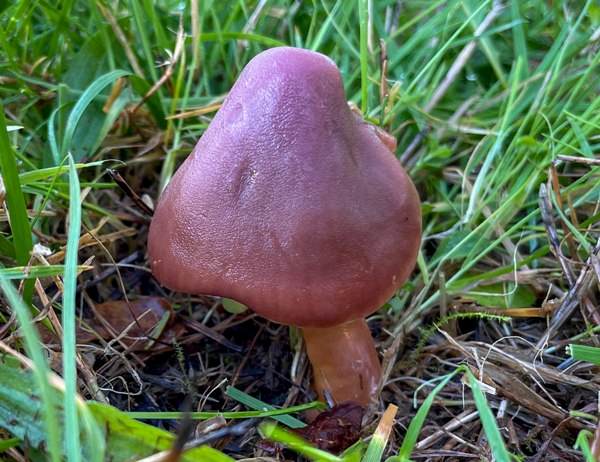
Known as the Jubilee Waxcap, this beautiful and robust waxcap mushroom appears in late summer and autumn. Unfortunately there are very few known locations of this very rare waxcap mushroom.
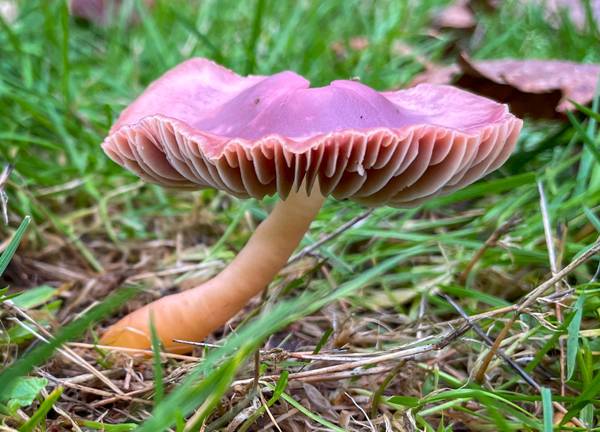
Distribution
As well as a very limited number of sites in England and Wales, the Jubilee Waxcap has also been recorded in Ireland, the Czech Republic, Denmark, France, Slovakia and Spain.
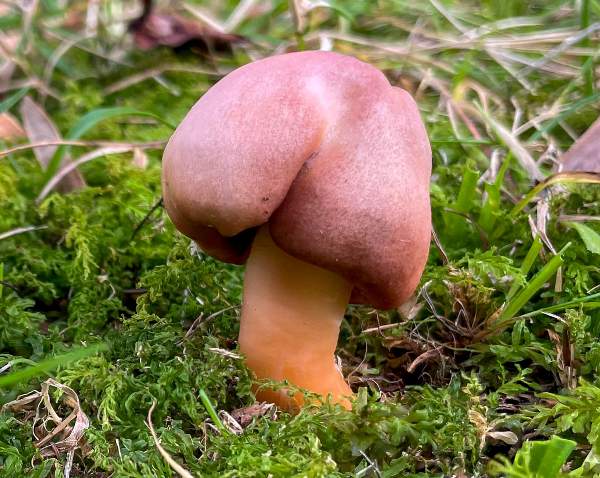
Taxonomic history
In 2013 Martyn Aynsworth, Paul Cannon and Bryn Dentinger, working in the mycology department at Kew Gardens, London, carried out DNA sequencing that identified this relative of the Parrot Waxcap as a separate waxcap species, and they named it Gliophorus reginae which is still its accepted scientific name. The holotype for this new species came from a site near Bewdley, in Worcestershire, England, where this lovely waxcap is reported to have been seen since the year 2000.
Hygrocybe sciophanoides var. carneoviolacea B. Lefebvre is a synonym of Gliophorus reginae.
Etymology
The genus Gliophorus comes from the from Greek glia-, meaning glue, and the Latin -phorus from the Greek -phoros which means bearing: Gliophorus refers to the glue-like thick liquid that coats the caps, gills and stems of mushrooms in this genus.
The specific epithet reginae as well as the common name named Jubilee Waxcap refer to Queen Elizabeth II. The common name commemorates the diamond jubilee of Her Majesty in 2012, the 60th anniversary of her late majesty's coronation.
Identification guide
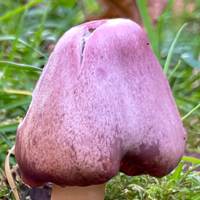 |
CapDusky pink to violet-purple, the cap is initially campanulate with an incurved margin, often lobed, but tends to flatten while retaining a broad umbo at maturity. Like most other waxcaps, the cap of the Jubilee Waxcap is prone to radial cracking. The hygrophanous cap is usually very slimy except during prolonged dry weather when it can turn pinkish-orange . Cap diameter at maturity is typically 1.5 to 5.5cm. |
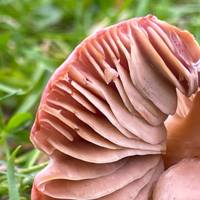 |
GillsThe widely-spaced waxy gills are not slimy. They have an adnexed (very narrow) attachment to the stipe with sometimes a few gills entirely free of the stem. At first pink, the gills become greyish-pink or brownish-pink as the fruitbody ages. There are interveins, which become more evident on fully-expanded specimens. The basidia are four-spored StemWhite or pinkish (but much paler than the cap) or very often orange coloured or with orange hues and with a yellow-tinged base; viscid (but less so than the caps), the stems are hollow and often flattened or grooved; typically 3 to 5cm tall and 0.5 to 1.5cm in diameter |
SporesEllipsoidal, smooth, 6.0-8.5 x 4-5.5µm, with an apical pore; inamyloid. Spore printWhite. |
|
Odour/taste |
Not distinctive. |
Habitat & Ecological role |
Cropped mossy grassland that has not been subject to artificial fertiliser treatment. The specimens shown on this page were fruiting in an ancient woodland / haymeadow habitat. Waxcaps have long been considered to be saprobic on the dead roots of grasses and other grassland plants, but it is now considered likely that there is some kind of mutual relationship between waxcaps and mosses. |
Season |
This is a late-fruiting waxcap and is usually found from October to late January in Britain and Ireland. |
Similar species |
Because of its strikingly distinctive cap colour, the Jubilee Waxcap is unlikely to be confused with any other species in the Hygrophoraceae family of fungi. Gliophorus psittacinus is a slime-covered waxcap of similar size; its cap is usually green, at least in parts, and the upper part of the stem remains green even at maturity. |
Culinary Notes
The Jubilee Waxcap is so rare that it should not be gathered for any purpose. This mushroom is listed as 'vulnerable' on the IUCN Red List of Threatened Species.
On a Europe-wide scale waxcap fungi are now quite rare, and so although in western Britain many of the acid-soil species are still plentiful most mycologists deplore the suggestion of these lovely fungi being gathered to eat. In any case most waxcaps are insubstantial and it is uncertain whether they are safe to eat.
Reference Sources
Gliophorus reginae Dentinger, A.M. Ainsw. & P.F. Cannon, in Ainsworth, Dentinger & Cannon, MycoKeys 7: 50 (2013)
BMS English Names of Fungi April 2022
Taxonomic history and synonym information on these pages is drawn from many sources but in particular from the British Mycological Society's GB Checklist of Fungi.
Acknowledgements
This page includes pictures kindly contributed by Tomas Milan.
Fascinated by Fungi. Back by popular demand, Pat O'Reilly's best-selling 450-page hardback book is available now. The latest second edition was republished with a sparkling new cover design in September 2022 by Coch-y-Bonddu Books. Full details and copies are available from the publisher's online bookshop...

